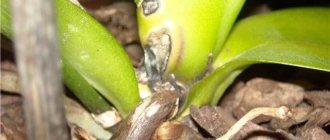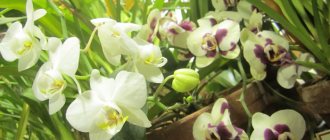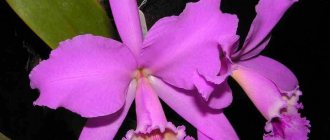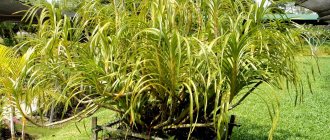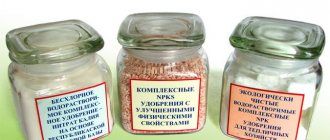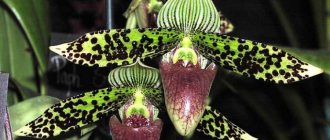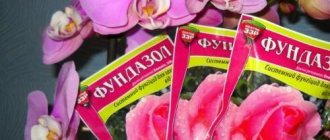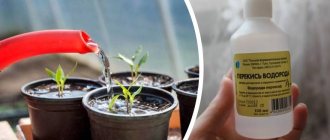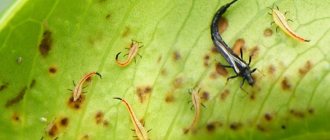Nutrient requirements
The need for nutrients directly depends on the time of year.
In spring and summer , thanks to long daylight hours and elevated temperatures, orchids can process more nutrients faster than in winter and autumn , when the temperature drops and daylight hours are shortened.
Each nutrient and the product of its transformation has its own purpose for the development and well-being of plants.
Depending on their role in metabolism, all nutrients can be divided into two groups:
- BUILDING ELEMENTS are substances necessary for a plant to form its organs (leaves, root system, etc.).
This group includes: proteins, fats, carbohydrates, organic acids, carbon, hydrogen, oxygen, nitrogen, phosphorus, sulfur, etc.
- FUNCTIONAL ELEMENTS are substances that influence certain processes occurring inside plants.
This group includes: potassium, calcium, magnesium, zinc, iron, boron, manganese, copper, molybdenum, chlorine and others.
Homemade fertilizer recipes for orchids
If it is not possible to buy American or Russian agrochemicals or you are a big fan of home-grown natural fertilizers, then you can prepare them yourself at home.
Banana peel supplement. Leave the crushed peel of one banana in 1 liter of drinking water at room temperature for 2 days. This infusion will contain microelements important for the orchid: nitrogen, potassium and magnesium. Immediately before watering, dilute this infusion with warm drinking water in the ratio: 1:1.
Potato decoction, cooled and strained for watering at the root, promotes an abundance of flower buds and prolonged flowering of the orchid.
Onion skins of onions. It is boiled and filtered to prepare a light-colored solution. The decoction is rich in microelements, but potassium is especially valuable for the plant.
Types and composition of fertilizers
There are 3 main groups of fertilizers:
- Organic;
- Inorganic;
- Chelates.
Organic fertilizers
They are of natural origin.
As a rule, these are waste products or decomposition products of animals and plants (bone meal, manure, humus, bird droppings, compost, etc.).
For the most part, such fertilizers contain nitrogen , which in its pure form is not available to plants.
In order for the orchid roots to begin to absorb such fertilizer, it must be processed by microorganisms.
This process directly depends on:
- composition and degree of substrate moisture;
- general temperature of the plants;
- total number of microorganisms.
The process of processing substances occurs uncontrollably.
Nitrogen may be produced either too little or too much.
In organic fertilizers, the remaining microelements necessary for orchids are either not contained at all or in a very low proportion.
Inorganic fertilizers
It is obtained synthetically by mixing macro- and microelements in certain doses.
Inorganic fertilizers are quickly absorbed by orchids, but they strongly salt the substrate and are difficult to wash out of the pot.
Most mineral complexes contain 3 main elements :
- Nitrogen (N);
- Phosphorus (P);
- Potassium (K).
The following can be added to the main elements in small quantities:
- Iron;
- Calcium;
- Manganese;
- Zinc;
- Molybdenum;
- Magnesium;
- Boron;
- Seru.
Fertilizer packages always contain the exact ratio of all three elements. For example, N:P:K = 10:4:7, which in turn means that nitrogen, phosphorus and potassium have a ratio of 10:4:7.
Sometimes the fertilizer packaging indicates the ratio of four numbers, the fourth being magnesium.
Modern complex fertilizers for orchids contain these microelements in different proportions.
Depending on the ratio of fertilizer elements, there are:
- Balanced;
- Nitrogen;
- Phosphorus.
A fertilizer with an NPK formula of 20-20-20, 12-12-12 or 6-6-6 is called balanced . There are equal amounts of all elements in such a fertilizer, but in absolute numbers there are most of them in the first formula.
The formula of nitrogen fertilizer is most often NPK 30:10:10. There is more nitrogen in this fertilizer than phosphorus and potassium.
Nitrogen fertilizer is used limitedly - at the beginning of the growing season for orchids planted in organic substrates (untreated bark, peat).
Organic substrates, immediately after the start of use, begin to decompose little by little and are colonized by bacteria, which absorb most of the available nitrogen. Therefore, the risk of overfeeding the orchid with nitrogen is minimal.
Phosphorus fertilizers, for example, NPK 10:30:20, are used to stimulate abundant flowering. The best time to apply phosphorus fertilizer is 1-2 months immediately before the expected flowering period.
More details about the signs of deficiency or excess in the next article.
Chelates
Unlike the first two varieties, they are absorbed by the root system (and leaves) almost instantly.
Chelate (from the Greek chele, “claw”) is a complex organic complex, a chemical combination of a trace element with a chelating (capturing) agent.
Such an agent firmly holds microelement ions in a soluble state until they enter the plant.
Then it releases it, converting it into a biologically accessible form, and itself breaks down into chemical compounds that are easily absorbed by plants.
Chelated fertilizers can be “ single ”, including only one microelement (for example, Fe-EDTA or Fe-DTPA), or they can be complex (for example, an aqueous solution of chelates of microelements Mn, Zn, Cu, Mo based on HEDP).
They have a positive effect not due to the substances they contain. Beneficial microorganisms simply facilitate the absorption of nutrients that are already present in the substrate.
With the correct dosage, in addition to the positive effect, they do not cause any obvious or hidden damage to the plant.
Elements necessary for successful color formation
Which fertilizer is best for orchids? In order for a plant to grow a flower arrow, it must receive the necessary elements in the form of :
- Nitrogen;
- Phosphorus;
- Potassium.
All of them are involved in the growth of the peduncle and their percentage content in mineral supplements is usually indicated on the packaging . In all fertilizers intended for orchids, these elements are collected in the required proportions, where nitrogen has a smaller share, which is reduced by almost half:
- Nitrogen is an essential element, important for the formation of leaf blades and their proper growth. Since normally developed leaves are the key to good nutrition of the bush. Its deficiency can be determined by small, unformed leaf blades;
- Phosphorus is the factor that influences the formation of the peduncle itself and without its participation it will not appear at all. It also affects the number of buds and the duration of flowering itself. The lack of an element can be seen in the appearance of the bush. He is depressed and practically does not grow;
- Potassium – is responsible for the correct and complete metabolism at the cellular level of the orchid. Develops immunity in the plant to various diseases that are inherent in this type of plant. If the buds bloom poorly and have a small diameter, then this is a lack of potassium.
Before purchasing fertilizer, pay attention to the expiration date.
When choosing fertilizers for Phalaenopsis, you need to pay attention to :
- For marking;
- Who is this mineral supplement intended for?
- For expiration date;
- And on the percentage composition of these three main elements.
So for spring fertilization, the nitrogen part should predominate or be at least on par with the other two main components. In the fall, when preparations are underway for flowering, fertilizer with a large amount of phosphorus is selected.
IMPORTANT! Whatever the content of these important three elements, the feeding itself should be labeled “for Phalaenopsis” and other orchid species.
Nitrogen fertilizers
Common nitrogen fertilizers for orchids:
- Substral Orchid Food for orchids;
- Bioekor for orchids.
As can be seen from the characteristics, nitrogen predominates in these fertilizers and is used in the spring during the vegetative growth of the plant.
When should it be applied and in what proportions?
Nitrogen fertilizers are applied at the moment when the flower’s dormant period ends and it begins to grow its foliage. This usually begins with the beginning of spring, since at this time, with an increase in heat and light, dormant buds wake up and sap flow begins.
Feeding scheme
Nitrogen fertilizers are applied twice a month, and they are diluted as indicated on the package, without increasing the dosage. Since this can lead to the death of the plant.
IMPORTANT! All fertilizing is applied only on moist soil and in a warm room.
Potassium-phosphorus fertilizers
Popular potassium-phosphorus fertilizers for orchids:
- Uniflor-bud;
- Fertika (kemira) for flowering plants.
Phosphorus-based fertilizers for orchids are often used.
Fertilizer Flower Happiness is also popular; many customers leave reviews.
Methods of depositing and deadlines
Such fertilizers begin to be applied with the arrival of autumn. There are two methods of fertilizing:
- Root;
- Foliar.
In the first case, the diluted fertilizer is poured into a suitable container and the orchid is placed there for a period of 20 minutes. In this case, from time to time it is necessary to shed the soil from above while this time passes. This is done so that the soil (bark) gets wet evenly . Then the flower is taken out of the container with fertilizer and the water is allowed to drain completely, tilting the container with the plant at an angle of 45 degrees.
In the second case, the foliage is sprayed , and water is removed from the axils of the Orchid so that the trunk does not begin to rot.
Monitor the amount of moisture applied to the leaf surface and remove excess to avoid rotting spots.
Scheme
Fertilizers are diluted according to the instructions printed on the package, without increasing the dosage, as this can lead to the death of the orchid bush. Fertilize the orchid with phosphorus-potassium fertilizers every 10 days.
Risks of overdose
It is better to underfeed an orchid than to overfeed it. When overdosed with fertilizers, its foliage shrinks, after which it turns yellow and disappears.
It is better to underfeed orchids than to overfeed them.
In this case, it is necessary to immediately begin resuscitation of the plant, since it will not help itself.
IMPORTANT! Do not increase the dosage or frequency of fertilizers.
Can it be used during flowering?
How to fertilize an orchid during flowering? You can fertilize your orchid with a large amount of potassium and phosphorus - this will help extend the flowering period and the formation of buds.
If such preparations are applied regularly, the flowers will have a more saturated hue and open fully, gaining diameter according to their specific description.
Therefore, you should pay attention to liquid fertilizers that will help extend the period of budding and flowering . Fertilizer must be carefully applied during flowering.
How to use?
Such preparations are administered with the beginning of the growth of the flower arrow and continue to be used throughout the period of bud formation. Fertilizers for flowering are applied at a rhythm of 2 times a week. This is especially important if there are 2-3 peduncles on the bush. In order for the plant to have enough strength, it needs help in building up the flower mass.
Consequences
When the buds are completely dissolved, you need to stop feeding the flower , as this can lead to premature aging of the flowers and they will begin to wrinkle and wither. At the same time, getting liquid on the flowers can ruin their appearance. Light brown spots will appear on the petals.
Fertilizing orchids at different periods of development
At different periods of orchid development, fertilizer compositions with different ratios of components are used.
The content of nitrogen, phosphorus and potassium in them depends on what phase the orchid is in:
- During the period of active growth, a fertilizer with a high nitrogen content is necessary, since nitrogen is responsible for the growth of vegetative mass.
- During planting and budding, fertilizer with a high content of phosphorus and potassium is necessary.
Is it possible to feed a blooming orchid?
Every gardener wants an orchid to bloom at home for as long as possible. Accordingly, the question arises, is it possible to feed a flowering plant?
In short, yes.
But there are certain nuances and rules, the observance of which will help prolong the flowering of phalaenopsis.
Firstly, you should only fertilize using the foliar method!
Secondly, when the plant produces a peduncle and buds begin to form on it, the flower can be fed with a liquid mixture of potassium and phosphorus.
Thirdly, when the flowers themselves appear, potassium preparations must be used. They will help maintain flowering for as long as possible.
REFERENCE. It is impossible to water with preparations, as the plant will redirect its forces from flowering to the absorption of fertilizers.
How to feed an orchid?
When deciding how to feed an orchid, it is worth taking into account the species characteristics and place of their growth in nature.
Feeding for epiphytes
Epiphytes include such representatives as phalaenopsis, vanda, cambria, dendrobium, etc.
Their nutrient requirements are low. In nature, these plants are content with the grains that rain washes off the trees.
IMPORTANT! For epiphytes, it is recommended to use only mineral fertilizers.
Feeding requirements for terrestrial species
Terrestrial orchids include some types of paphiopedilum, growing in rock crevices where various organic remains, cymbidium, ludisia, etc. accumulate.
Their need for nutrients is higher, because decomposing organic remains are always present on the ground (rotted leaves, grass, branches, animal waste products).
They respond well to the addition of organic matter, in addition to mineral complexes. For example, cymbidiums often refuse to bloom unless organic matter with a sufficiently high nitrogen content is added.
IMPORTANT! Before using the fertilizer, be sure to read the instructions for its use. Strictly observe the dosage.
How does an orchid feed in nature?
Orchids are perennial herbaceous plants that grow either on the ground or wrap their roots around other plants. But what does this unusual plant eat?
Most of them are autotrophs - they have the ability to independently synthesize inorganic substances into organic ones. Terrestrial orchids exist only through symbiosis with a certain group of fungi.
The aerial roots of epiphytic orchids, hanging from the stem and enveloping the tree trunk, are covered with a thick layer of velamen, which, like a sponge, absorbs moisture from rain, dew, and air.
Leaves that have fallen from the crown, insect remains, and tropical debris get stuck on these roots from the wind, which ultimately turns into a kind of humus.
The fleshy leaves and stem accumulate water reserves . And the roots and leaves, having the ability of photosynthesis, process the particles settling on them into nutritious organic substances.
Orchids that are terrestrial or that settle on rotten, rotting remains of wood, which are not capable of photosynthesis and do not have the ability to extract nutrients, parasitize on fungi that settle on their roots. It is these fungi, penetrating the mycelium into the cells of the root system, that nourish the plant.
Fertilizer application methods
There are two ways to deposit:
- Root feeding.
Using this method, the roots are soaked or spilled with a solution containing fertilizer.
- Foliar (foliar) feeding.
Fertilizers are applied to the leaves, most often using a spray bottle. Since most of the stomata on leaves are located on the lower part of the leaf, this is where fertilizer should be sprayed.
Foliar feeding can be used in parallel with root feeding, or can be used independently when the orchid does not have roots or it is necessary to deliver microelements directly to the leaves (for example, during chlorosis).
IMPORTANT! The use of fertilizers in the form of sticks or tablets is not recommended, since in conditions of breathable substrates based on the bark of coniferous trees, they have a very small positive effect on orchids.
When to water an orchid with fertilizers
It is not always possible to water an orchid so that it blooms.
For example, root feeding of sick specimens is prohibited. In addition, after transplantation, the plant needs to get used to its new location. Therefore, there is no need to feed the flower at this time either.
If you haven’t watered your phalaenopsis with clean water for a long time, then in this case you can’t feed it either. Otherwise, there is a high risk of burning the roots with “chemistry”.
It is also prohibited to water flowering phalaenopsis with liquid compounds. At this time, only spraying with nutrient compositions is used.
Rules for feeding orchids
It is best to use a specialized fertilizer, marked on the package “For orchids,” since they are specially balanced in relation to the needs of the orchid and cause the least harm to their root system.
The substrate is a special microclimate where various bacteria, fungi and other microorganisms live.
When fertilizing, you fertilize not only the orchid itself, but this entire friendly family taken together.
Each component of which, to one degree or another, is involved in the processing of fertilizer in order to extract useful elements from it and present them to the orchid roots in a form accessible for absorption.
The processing of many useful substances takes a fairly long period - first they accumulate in the substrate, are gradually processed by microorganisms, and then end up inside the orchid.
The older the substrate , the greater the number of such elements it contains , and the higher the likelihood that too many substances will accumulate and they will become toxic to nearby roots.
Salinization of the substrate will occur , followed by massive death of roots.
In order to avoid this, orchids growing for a long time in old substrates need to be fertilized an order of magnitude less often than in new ones.
The opposite situation occurs inside pots of recently transplanted orchids .
At first, the microflora necessary for the further promotion of beneficial substances is practically completely absent.
To build it, you will need not only a certain period of time, but also a large amount of nitrogen (especially in clean bark).
It is not uncommon during this period when orchids begin to suffer from a lack of it, turning yellow and dropping leaves, because all the nitrogen available for nutrition is spent on building new microflora.
Brands of fertilizers suitable for orchids
Previous mineral fertilizers have been replaced by preparations containing substances in the most accessible form for absorption. One of these fertilizers is the Finnish brand Kemira. For orchids, one of the types of fertilizers used is this one. This form is suitable not only for orchids, but also for other indoor flowers and garden crops. How to fertilize an orchid with Kemira Lux fertilizer can be read in the instructions for the package.
Among root fertilizers, the complex fertilizers Master-Color, Pocon and Greenworld are considered good. Pocon increases resistance to diseases. Greenworld extends flowering time. Among the Master-color line, “universal” is used for the growth of roots and leaves, and “orchid” is used during the laying of flower stalks.
Knowing how to feed an orchid at different stages of its life, you can achieve large and beautiful flowers, and extend the flowering period a little
(
6 ratings, average: 4.67 out of 5)
Nutrient deficiencies
You can regularly fertilize an orchid , but it will still suffer from a lack of one or another substance.
Why is this happening? The main reason lies in the suboptimal acidity of the substrate, determined by pH.
The optimal value for most types of orchids is between 5.5 and 6.5 pH . When the pH is below 5 or above 6.8 pH, an unfavorable environment is formed inside the substrate and the orchid root system stops consuming many nutrients.
In acidic soils (pH 4.0-5.5), iron, aluminum and manganese are in forms available to plants, and their concentrations reach toxic levels. At the same time, the supply of phosphorus, potassium, sulfur, calcium, magnesium, and molybdenum to plants is difficult.
In alkaline conditions (pH 7.5-8.5), iron, manganese, phosphorus, copper, zinc, boron and most trace elements become less available to plants.
What affects the decrease or increase in pH of the substrate?
From frequent watering, many organic components of the substrate begin to decompose, and its pH decreases. This indicator increases due to frequent fertilizers or watering with (hard) tap water.
The roots of many epiphytic orchids are very sensitive to various types of potassium, phosphorus, etc. salts contained in fertilizers and exposure to highly concentrated fertilizer can cause burns.
REMEMBER that ordinary fertilizers for indoor plants are oriented towards action in ordinary soil and for absorption by ordinary, NOT EPIPHYTIC roots, so their main drawback is the rapid salinization of the substrate, which creates an unfavorable environment for the root system of orchids inside the pots, in especially sad cases leading to their mass die-off.
How to fertilize an orchid, taking into account the growing season
Traditional methods: root - watering into a tray or on top of the roots; foliar - spraying from a spray bottle on the leaves. Spray the leaves on both sides, trying not to get the spray on the opened flowers and buds to avoid the formation of rot.
There are specific indications for spraying:
- with active plant growth;
- if the roots are damaged and it is impossible to feed the orchid through the soil substrate;
- with leaf chlorosis.
Spraying is carried out in the evening or in the morning at room temperature up to +30C. The leaf axils and growing point should remain dry to avoid the development of rot. Before spraying, the orchid is watered to cause active sap flow, during which the foliar fertilizer will be absorbed faster and more fully. After a few days, the greenness of the leaves, their shine and elasticity will increase.
Root feeding is intended for healthy plants. For such feeding, the substrate is first moistened generously with warm, settled water. After this, the pot with the orchid is placed in a bowl with a nutrient solution for 15 minutes and additionally watered under the root. Then allow the pot with the orchid to be completely freed from the nutrient solution and return it to the tray.
The role of macroelements in the life of orchids
Calcium
Responsible for growing roots, regulating the pH of the substrate (the norm is 5.5-6.5), and helps cells divide and multiply.
The plant practically does not absorb calcium from the external environment, and therefore regularly needs additional calcium feeding.
- With an excess of calcium , orchid cells are destroyed, especially at the ends of young shoots.
- With calcium deficiency, plants become lethargic and soft.
Magnesium
It is involved in the formation of chlorophyll, helps the plant absorb water and move it through the tissues.
- If there is an excess of magnesium, the orchid stops receiving potassium, which leads to potassium deficiency with all the unpleasant consequences.
- With magnesium deficiency, light yellow or greenish spots appear on adult leaves, which then turn black (the leaf veins do not change color).
Zinc
Promotes the synthesis of enzymes and the formation of chlorophyll, which is responsible for the color of leaves.
- With an excess of zinc, the leaves acquire a marbled color and become distorted. The orchid itself stops growing and blooming (it can stand without flowers for up to 3 years).
- Zinc deficiency has not been scientifically identified.
Iron
It also takes part in the formation of chlorophyll and the synthesis of most enzymes, and helps absorb nitrogen.
- If there is an excess of iron, which is very rare, plants stop growing and refuse to bloom for two years.
- With iron deficiency, young orchid leaves grow very slowly and have dwarf sizes. They acquire yellow streaks or light spots that quickly spread over the surface. Leaf tissue begins to die from the edges.
Copper
Strengthens the immunity of orchids, participates in the production of enzymes and proteins, and protects against fungi.
- If there is an excess of copper , the leaves become reddish and the plant slows down its growth.
- With a copper deficiency , the orchid stops blooming and the leaves take on a twisted shape.
Bor
Participates in the formation of cells and pollen of orchids and metabolic processes, accelerates the synthesis and movement of carbohydrates such as sucrose.
- The effect of excess boron has not been studied.
- With boron deficiency, roots, shoots, growth points and leaves die, the plant cannot breathe normally and produce enzymes. The leaves acquire a dark green color, become hard as stone, and curl their edges down.
Manganese
Actively participates in metabolic processes, photosynthesis and enzyme production.
- With an excess of manganese, interveinal chlorosis occurs, when the veins remain the same color, and the space between them turns yellow, small yellow spots form.
- With a deficiency of manganese , leaf growth slows down and spots appear on the tips.
Sulfur
Helps produce enzymes, chlorophyll and protein cells, absorb nitrogen, grow the root system and form seeds.
By receiving enough sulfur, plants are not afraid of temperature changes, moisture deficiency and even radiation.
- When there is an excess of sulfur, orchid leaves begin to turn yellow at the edges and curl inward, then turn brown and die. New leaves grow coarse and small.
- With sulfur deficiency, interveinal chlorosis is observed.
What to feed?
Folk remedies or chemical preparations can serve as a source of additional nutrition. Manure or compost is used only for terrestrial varieties of orchids.
Fertilize plants only when clearly necessary. It is better to slightly underfeed the flower and dilute the fertilizer with a large volume of water than to oversaturate it.
There are several ways to apply fertilizing:
- Root. After abundant watering, the nutrient solution is added directly to the pot. After half an hour, excess liquid is removed.
- Foliar. Used during the flowering period. It involves applying a nutritional composition to the leaves by spraying.
- Combined. It involves the alternate use of the two above methods.
Important! The inflorescences should not be fertilized. This may cause burns.
The best folk fertilizers
Natural ingredients can serve as additional nutrition for orchids. The following compositions are especially popular among gardeners:
- Coffee or tea grounds. Natural acidifiers of the substrate. Contains essential minerals in small quantities.
- Banana peel infusion. To prepare it, add 1 liter of warm water to the peel of one banana and leave for 2-3 days. Then another 1 liter of water is added to the resulting solution.
- Potato broth. It is cooled and filtered. Used for root feeding.
- Infusion of onion peels. Protects the plant from rotting and disease development. For 1 tbsp. husks will need 3 liters of boiling water. Leave for 8 hours. Then dilute with water in a ratio of 1:3.
- Wood ash. The best option is from coniferous species. It contains more useful minerals. For 200 g of ash, 1 liter of water is used.
Traditional medicines are always available and easy to use. But it is necessary to comply with the indicated dosage.
Special means
They allow you to extend the flowering period and saturate them with essential microelements. It is advisable to use fertilizers in liquid form. They are more easily absorbed by plants.
Indoor orchids can be fed with the following preparations:
- "Bona Forte". Extends the flowering period to 6 months.
- "Flora". Made on the basis of natural ingredients - it is an extract from humus. Available in spray form.
- "Emerald". Prevents yellowing of foliage.
- "Dr. Foley." Suitable for regular spraying.
Until the buds appear, the amount of water specified in the instructions is multiplied by 2. And after their final formation, liquid fertilizers are diluted in accordance with the recommendations on the packaging.
First aid kit for orchids
An orchid is a living organism that, like all organisms, needs the prevention and treatment of diseases. Some medications should always be on hand:
Charcoal is an effective fungicide that kills fungal pathogens. Used to disinfect and dry cut areas.
Charcoal is used against fungal diseases.
If a flower is infected with powdery mildew, snow mold, root rot, late blight, scab, blackleg and other serious fungal diseases, systemic fungicides such as foundationazole or phytosporin . The affected areas are treated with a porridge-like mixture of these fungicides (0.5 tsp of powder per 1 tsp of water), and when sprayed, dilute 1 tsp. powder per liter of water.
Pathogens and parasites are another scourge that effective insecticides .
Aktelik, Apollo, Fitoverm kill ticks, aphid larvae, whiteflies, scale insects, leaf-eating caterpillars, etc.
From time to time, orchids need resuscitation; in such cases, they resort to the help of biostimulants :
- A few drops of epin or zircon during root feeding give very good results. The plant receives a powerful additional impetus for growth;
- urea is a nitrogen fertilizer. It is used for the growth of leaves and shoots during the period when phalaenopsis is emerging from winter dormancy;
- fluconazole is a broad-spectrum pharmaceutical antibiotic;
- iron chelate – used for chlorosis;
- Chlorhexidine is used to treat wounds for various rots.
Often in reviews about growing orchids at home on a windowsill, you can come across the opinion that this flower is not intended for life at home, that it dies soon after being purchased in a store. It's worth figuring out why this sometimes happens.
The fact is that caring for an orchid should begin immediately after purchasing it. The first thing to do is to quarantine it from other flowers located in the room. Quarantine for orchids should be at least two weeks. During this time, adaptation to new conditions will occur, and this time will also provide an opportunity to identify pests if they are present.
The purchased orchid is separated from other plants.
The best place for a newly purchased orchid is away from direct sunlight. You should not feed the plant at this time. She doesn't need any extra stress. After two weeks, the orchid is placed on the windowsill and begins to accustom it to sunlight and watering.
Most popular fertilizers
There are many proven liquid mineral fertilizers available on the market today. There are several of the most popular :
- Agricola is a gel-like effective mineral fertilizer for root feeding. Promotes the rapid growth of healthy flowers, dissolves well in water. 5 ml of gel is dissolved in 1 liter of water, used once every two weeks;
- Zircon is a liquid preparation for root feeding. Strengthens the root system, provides a powerful stimulus for the formation of new buds. The fertilizer is diluted at the rate of 1 ml per 10 liters of water;
- Epin is another stimulator of the development of healthy roots, a source of vitamins and protection of the plant’s immune system. Used twice a month for both irrigation and full immersion;
Epin.
- Dr. Foley - the preparation contains a complex of amino acids and vitamins for the full development of phalaenopsis. It is used for both root and foliar feeding. Apply once every 14 days;
- Bona Forte is one of the best liquid products that ensures long flowering of the orchid (up to six months) and the growth of new side shoots. The ratio is: 10 ml of the drug per 15 liters of water;
- Brexil Combi is an excellent fertilizer for orchids with chlorosis. Replenishes iron deficiency, providing the infected plant with the entire complex of vitamins and minerals. For root feeding, 5 ml of the drug is diluted in a bucket of water.
Along with universal fertilizer complexes, experienced gardeners advise using a number of growth stimulants . Such preparations enhance the beneficial effects of mineral supplements. Here are some of them:
- Peat oxidate . The humic substances contained in this additive have many beneficial properties: they accumulate useful minerals and vitamins in the soil, remove toxins from the plant, and improve cell nutrition. 40 ml of oxidate is diluted in a bucket of water;
- Kornevin . Used to stimulate the growth of the root system of orchids. 5 grams of dry herbal medicine powder are dissolved in 5 liters of water and watered once a month;
- Vermicompost . The high nitrogen content in this preparation promotes active growth of green mass. Can be used twice a year, but not during the flowering period;
- Florhumate . An excellent stimulant with a wide spectrum of action, enhances root growth, prolongs the flowering period, and increases plant resistance to disease. When root feeding, 10 ml of liquid phlorhumate is dissolved in 1 liter of water.



